seats FORD F450 2015 Owners Manual
[x] Cancel search | Manufacturer: FORD, Model Year: 2015, Model line: F450, Model: FORD F450 2015Pages: 485, PDF Size: 5.35 MB
Page 4 of 485
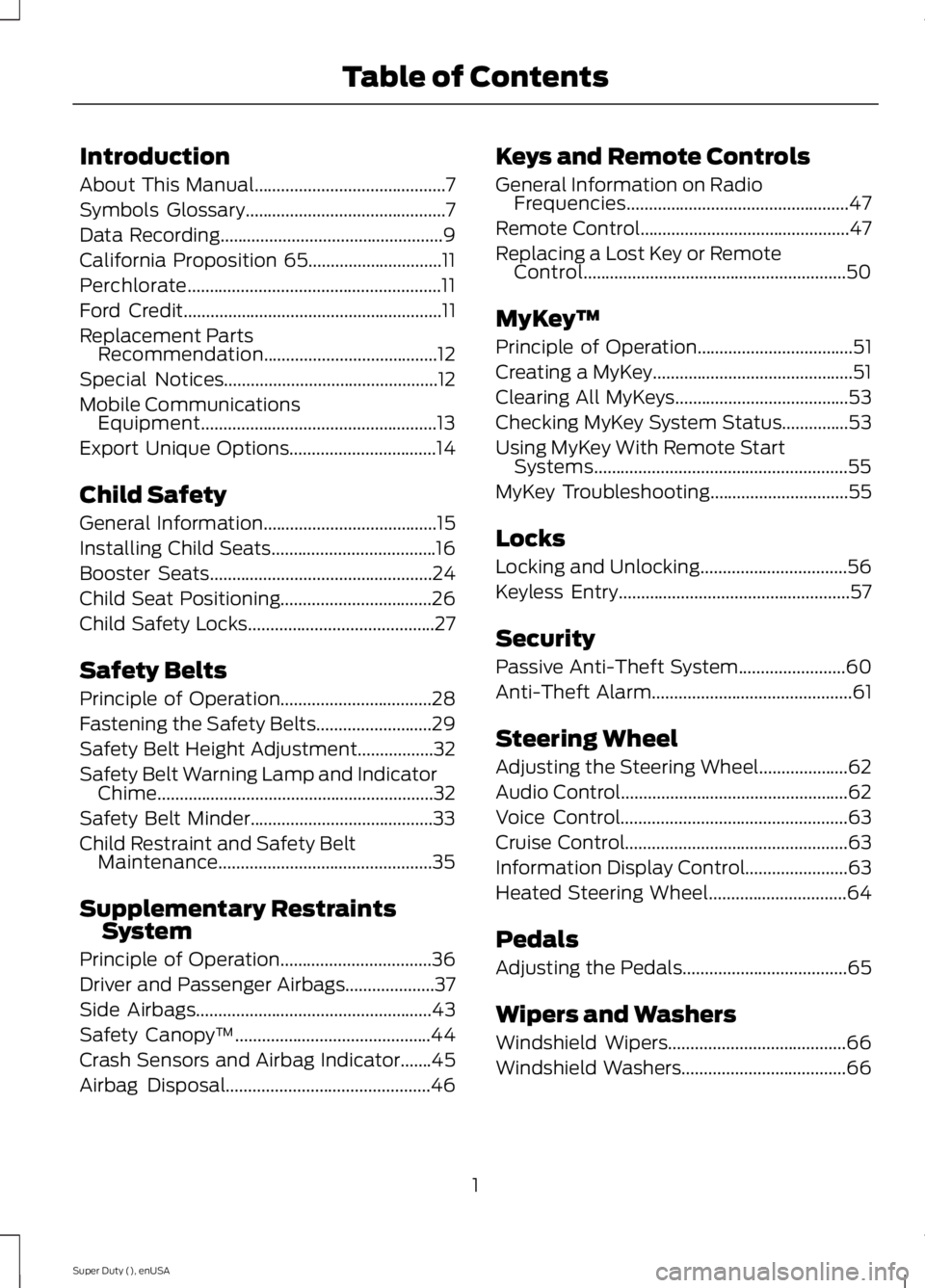
Introduction
About This Manual...........................................7
Symbols Glossary
.............................................7
Data Recording
..................................................9
California Proposition 65..............................11
Perchlorate.........................................................11
Ford Credit
..........................................................11
Replacement Parts Recommendation.......................................12
Special Notices................................................12
Mobile Communications Equipment.....................................................13
Export Unique Options
.................................14
Child Safety
General Information
.......................................15
Installing Child Seats.....................................16
Booster Seats
..................................................24
Child Seat Positioning..................................26
Child Safety Locks..........................................27
Safety Belts
Principle of Operation
..................................28
Fastening the Safety Belts
..........................29
Safety Belt Height Adjustment.................32
Safety Belt Warning Lamp and Indicator Chime
..............................................................32
Safety Belt Minder.........................................33
Child Restraint and Safety Belt Maintenance
................................................35
Supplementary Restraints System
Principle of Operation..................................36
Driver and Passenger Airbags....................37
Side Airbags
.....................................................43
Safety Canopy ™
............................................44
Crash Sensors and Airbag Indicator.......45
Airbag Disposal
..............................................46 Keys and Remote Controls
General Information on Radio
Frequencies..................................................47
Remote Control
...............................................47
Replacing a Lost Key or Remote Control...........................................................50
MyKey ™
Principle of Operation
...................................51
Creating a MyKey.............................................51
Clearing All MyKeys.......................................53
Checking MyKey System Status...............53
Using MyKey With Remote Start Systems.........................................................55
MyKey Troubleshooting...............................55
Locks
Locking and Unlocking
.................................56
Keyless Entry
....................................................57
Security
Passive Anti-Theft System........................60
Anti-Theft Alarm
.............................................61
Steering Wheel
Adjusting the Steering Wheel....................62
Audio Control
...................................................62
Voice Control
...................................................63
Cruise Control
..................................................63
Information Display Control.......................63
Heated Steering Wheel
...............................64
Pedals
Adjusting the Pedals.....................................65
Wipers and Washers
Windshield Wipers
........................................66
Windshield Washers.....................................66
1
Super Duty (), enUSA Table of Contents
Page 5 of 485
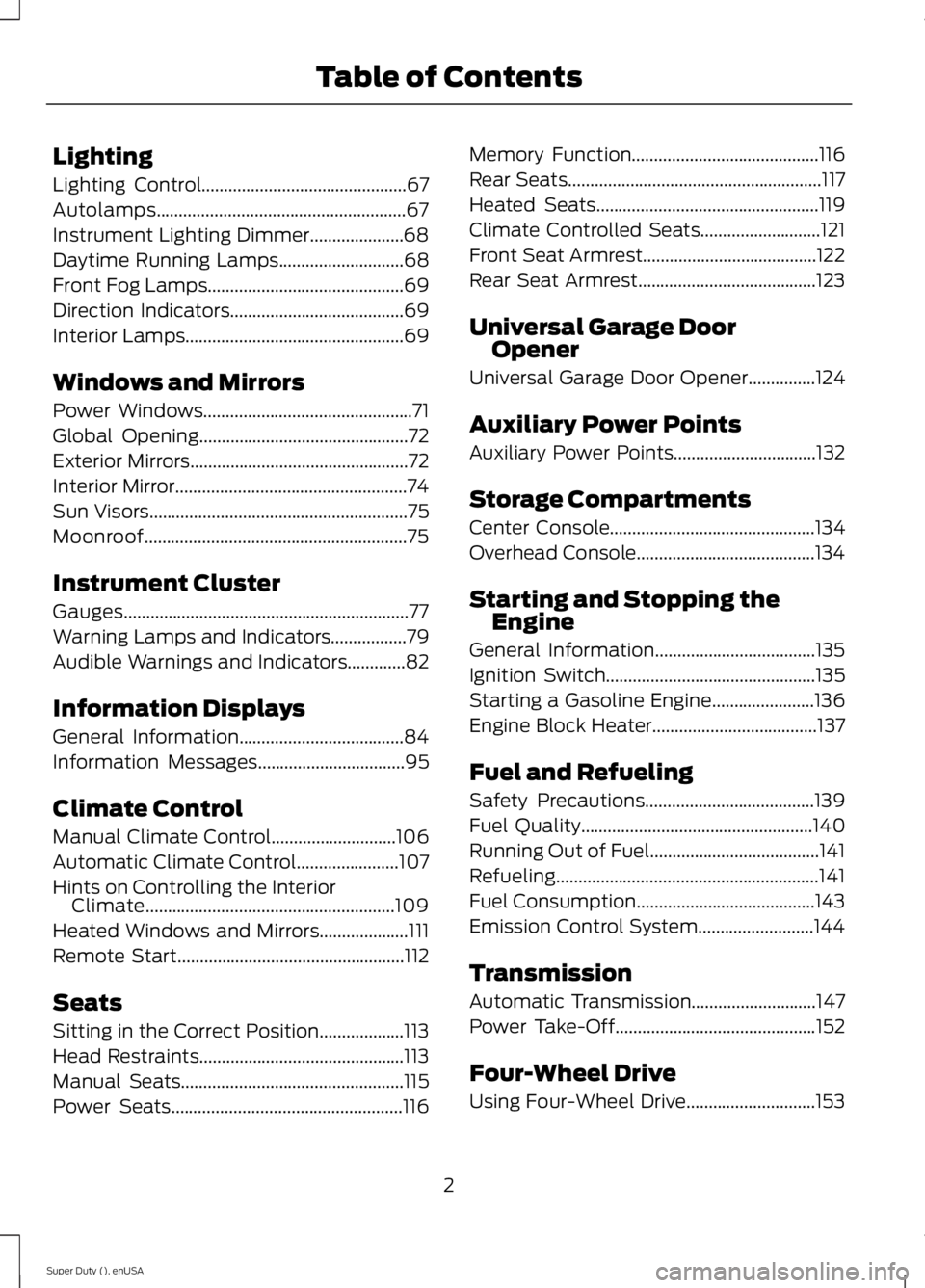
Lighting
Lighting Control..............................................67
Autolamps........................................................67
Instrument Lighting Dimmer.....................68
Daytime Running Lamps
............................68
Front Fog Lamps............................................69
Direction Indicators
.......................................69
Interior Lamps.................................................69
Windows and Mirrors
Power Windows
...............................................71
Global Opening
...............................................72
Exterior Mirrors
.................................................72
Interior Mirror
....................................................74
Sun Visors
..........................................................75
Moonroof...........................................................75
Instrument Cluster
Gauges................................................................77
Warning Lamps and Indicators.................79
Audible Warnings and Indicators.............82
Information Displays
General Information
.....................................84
Information Messages
.................................95
Climate Control
Manual Climate Control
............................106
Automatic Climate Control
.......................107
Hints on Controlling the Interior Climate........................................................109
Heated Windows and Mirrors....................111
Remote Start
...................................................112
Seats
Sitting in the Correct Position...................113
Head Restraints..............................................113
Manual Seats
..................................................115
Power Seats
....................................................116 Memory Function
..........................................116
Rear Seats
.........................................................117
Heated Seats
..................................................119
Climate Controlled Seats...........................121
Front Seat Armrest.......................................122
Rear Seat Armrest........................................123
Universal Garage Door Opener
Universal Garage Door Opener
...............124
Auxiliary Power Points
Auxiliary Power Points................................132
Storage Compartments
Center Console
..............................................134
Overhead Console........................................134
Starting and Stopping the Engine
General Information....................................135
Ignition Switch
...............................................135
Starting a Gasoline Engine.......................136
Engine Block Heater.....................................137
Fuel and Refueling
Safety Precautions......................................139
Fuel Quality
....................................................140
Running Out of Fuel......................................141
Refueling...........................................................141
Fuel Consumption
........................................143
Emission Control System..........................144
Transmission
Automatic Transmission
............................147
Power Take-Off
.............................................152
Four-Wheel Drive
Using Four-Wheel Drive
.............................153
2
Super Duty (), enUSA Table of Contents
Page 7 of 485
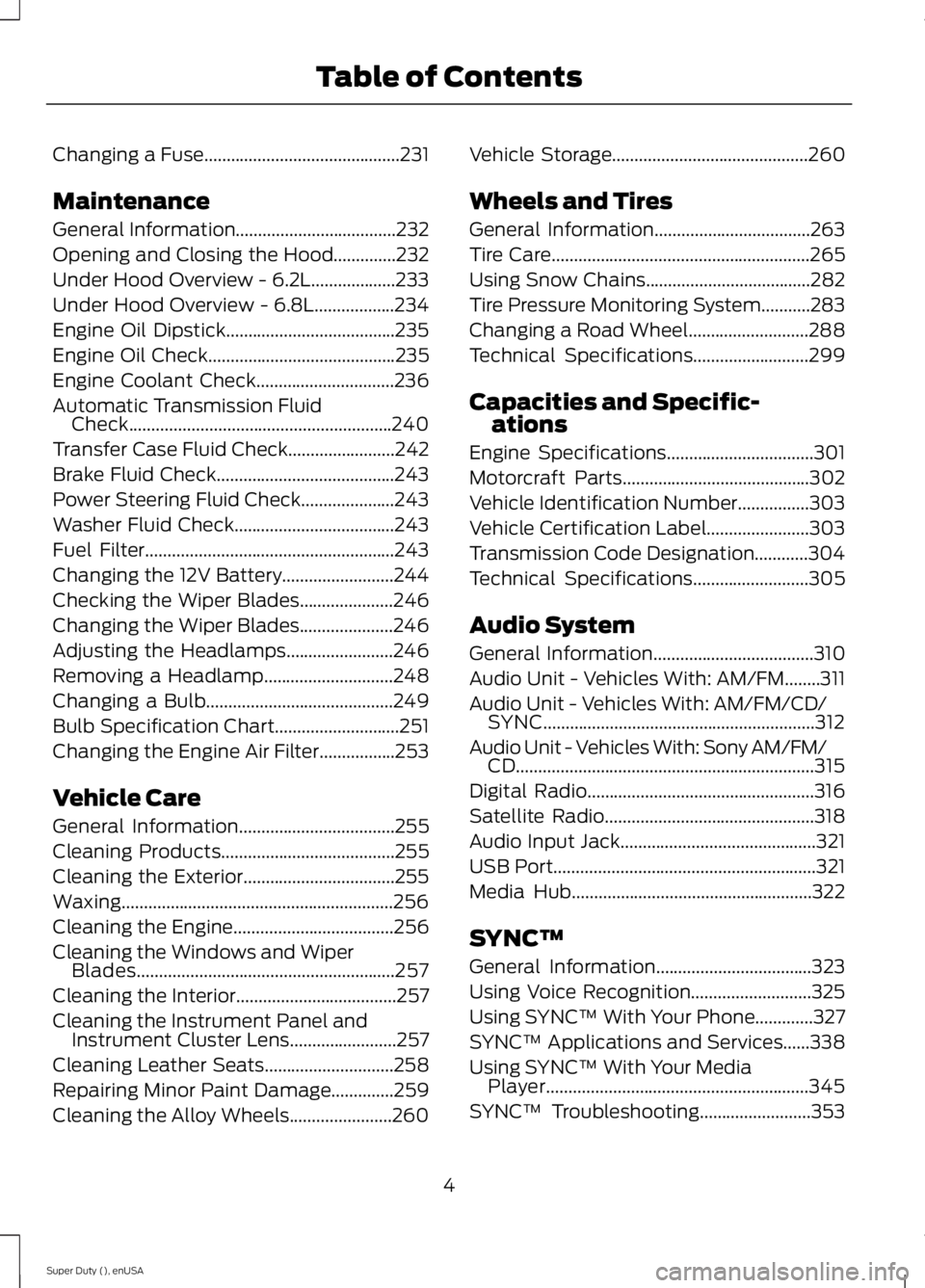
Changing a Fuse............................................231
Maintenance
General Information
....................................232
Opening and Closing the Hood..............232
Under Hood Overview - 6.2L...................233
Under Hood Overview - 6.8L..................234
Engine Oil Dipstick......................................235
Engine Oil Check
..........................................235
Engine Coolant Check
...............................236
Automatic Transmission Fluid Check...........................................................240
Transfer Case Fluid Check........................242
Brake Fluid Check
........................................243
Power Steering Fluid Check.....................243
Washer Fluid Check....................................243
Fuel Filter
........................................................243
Changing the 12V Battery.........................244
Checking the Wiper Blades
.....................246
Changing the Wiper Blades.....................246
Adjusting the Headlamps........................246
Removing a Headlamp
.............................248
Changing a Bulb..........................................249
Bulb Specification Chart............................251
Changing the Engine Air Filter.................253
Vehicle Care
General Information
...................................255
Cleaning Products
.......................................255
Cleaning the Exterior..................................255
Waxing.............................................................256
Cleaning the Engine
....................................256
Cleaning the Windows and Wiper Blades..........................................................257
Cleaning the Interior....................................257
Cleaning the Instrument Panel and Instrument Cluster Lens
........................257
Cleaning Leather Seats
.............................258
Repairing Minor Paint Damage
..............259
Cleaning the Alloy Wheels.......................260 Vehicle Storage
............................................260
Wheels and Tires
General Information
...................................263
Tire Care
..........................................................265
Using Snow Chains.....................................282
Tire Pressure Monitoring System...........283
Changing a Road Wheel
...........................288
Technical Specifications..........................299
Capacities and Specific- ations
Engine Specifications
.................................301
Motorcraft Parts..........................................302
Vehicle Identification Number................303
Vehicle Certification Label.......................303
Transmission Code Designation............304
Technical Specifications
..........................305
Audio System
General Information
....................................310
Audio Unit - Vehicles With: AM/FM........311
Audio Unit - Vehicles With: AM/FM/CD/ SYNC
.............................................................312
Audio Unit - Vehicles With: Sony AM/FM/ CD...................................................................315
Digital Radio...................................................316
Satellite Radio
...............................................318
Audio Input Jack............................................321
USB Port
...........................................................321
Media Hub......................................................322
SYNC™
General Information
...................................323
Using Voice Recognition...........................325
Using SYNC™ With Your Phone.............327
SYNC™ Applications and Services......338
Using SYNC™ With Your Media Player...........................................................345
SYNC™ Troubleshooting
.........................353
4
Super Duty (), enUSA Table of Contents
Page 15 of 485
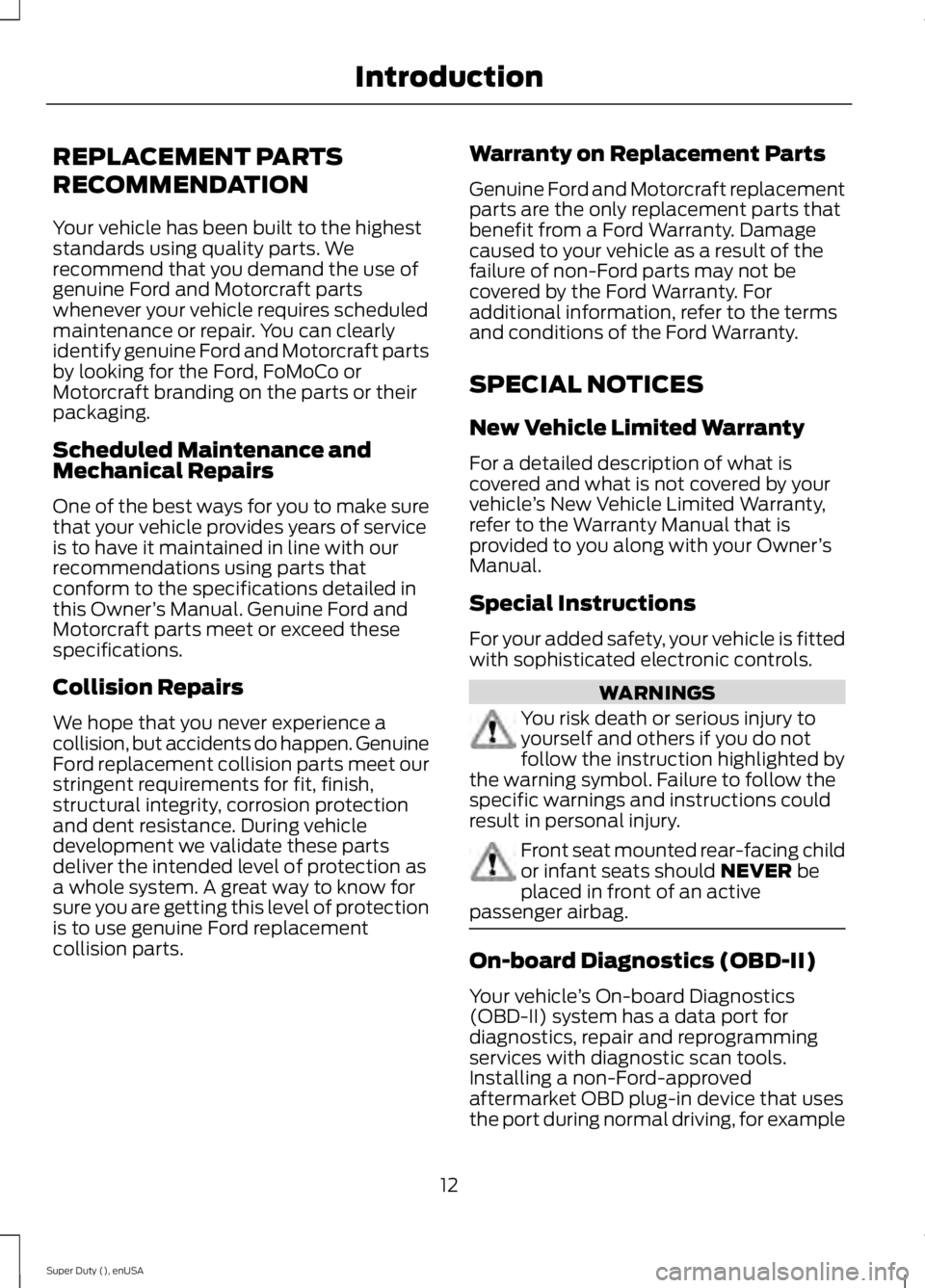
REPLACEMENT PARTS
RECOMMENDATION
Your vehicle has been built to the highest
standards using quality parts. We
recommend that you demand the use of
genuine Ford and Motorcraft parts
whenever your vehicle requires scheduled
maintenance or repair. You can clearly
identify genuine Ford and Motorcraft parts
by looking for the Ford, FoMoCo or
Motorcraft branding on the parts or their
packaging.
Scheduled Maintenance and
Mechanical Repairs
One of the best ways for you to make sure
that your vehicle provides years of service
is to have it maintained in line with our
recommendations using parts that
conform to the specifications detailed in
this Owner
’s Manual. Genuine Ford and
Motorcraft parts meet or exceed these
specifications.
Collision Repairs
We hope that you never experience a
collision, but accidents do happen. Genuine
Ford replacement collision parts meet our
stringent requirements for fit, finish,
structural integrity, corrosion protection
and dent resistance. During vehicle
development we validate these parts
deliver the intended level of protection as
a whole system. A great way to know for
sure you are getting this level of protection
is to use genuine Ford replacement
collision parts. Warranty on Replacement Parts
Genuine Ford and Motorcraft replacement
parts are the only replacement parts that
benefit from a Ford Warranty. Damage
caused to your vehicle as a result of the
failure of non-Ford parts may not be
covered by the Ford Warranty. For
additional information, refer to the terms
and conditions of the Ford Warranty.
SPECIAL NOTICES
New Vehicle Limited Warranty
For a detailed description of what is
covered and what is not covered by your
vehicle
’s New Vehicle Limited Warranty,
refer to the Warranty Manual that is
provided to you along with your Owner ’s
Manual.
Special Instructions
For your added safety, your vehicle is fitted
with sophisticated electronic controls. WARNINGS
You risk death or serious injury to
yourself and others if you do not
follow the instruction highlighted by
the warning symbol. Failure to follow the
specific warnings and instructions could
result in personal injury. Front seat mounted rear-facing child
or infant seats should NEVER be
placed in front of an active
passenger airbag. On-board Diagnostics (OBD-II)
Your vehicle
’s On-board Diagnostics
(OBD-II) system has a data port for
diagnostics, repair and reprogramming
services with diagnostic scan tools.
Installing a non-Ford-approved
aftermarket OBD plug-in device that uses
the port during normal driving, for example
12
Super Duty (), enUSA Introduction
Page 18 of 485
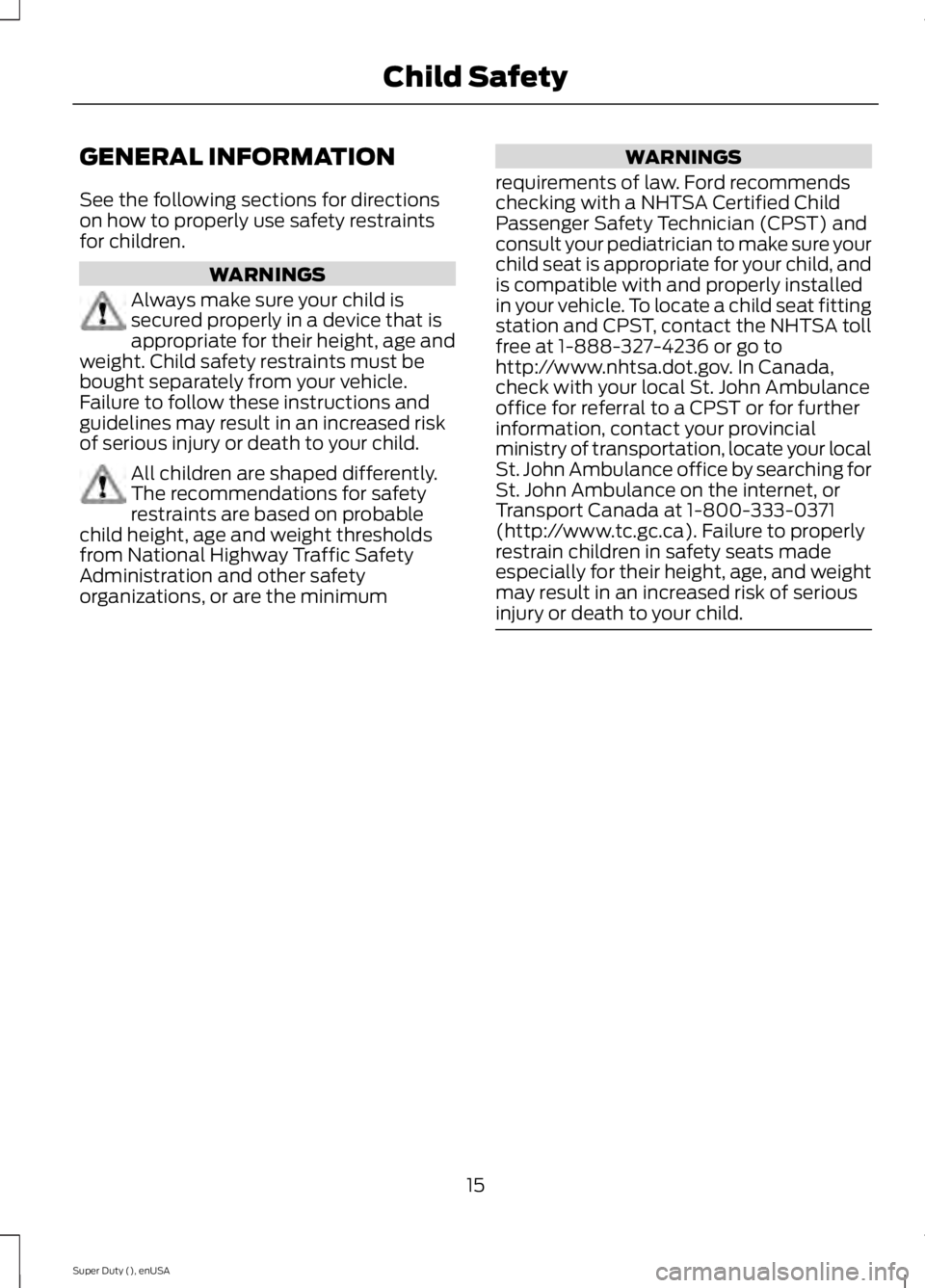
GENERAL INFORMATION
See the following sections for directions
on how to properly use safety restraints
for children.
WARNINGS
Always make sure your child is
secured properly in a device that is
appropriate for their height, age and
weight. Child safety restraints must be
bought separately from your vehicle.
Failure to follow these instructions and
guidelines may result in an increased risk
of serious injury or death to your child. All children are shaped differently.
The recommendations for safety
restraints are based on probable
child height, age and weight thresholds
from National Highway Traffic Safety
Administration and other safety
organizations, or are the minimum WARNINGS
requirements of law. Ford recommends
checking with a NHTSA Certified Child
Passenger Safety Technician (CPST) and
consult your pediatrician to make sure your
child seat is appropriate for your child, and
is compatible with and properly installed
in your vehicle. To locate a child seat fitting
station and CPST, contact the NHTSA toll
free at 1-888-327-4236 or go to
http://www.nhtsa.dot.gov. In Canada,
check with your local St. John Ambulance
office for referral to a CPST or for further
information, contact your provincial
ministry of transportation, locate your local
St. John Ambulance office by searching for
St. John Ambulance on the internet, or
Transport Canada at 1-800-333-0371
(http://www.tc.gc.ca). Failure to properly
restrain children in safety seats made
especially for their height, age, and weight
may result in an increased risk of serious
injury or death to your child. 15
Super Duty (), enUSA Child Safety
Page 19 of 485
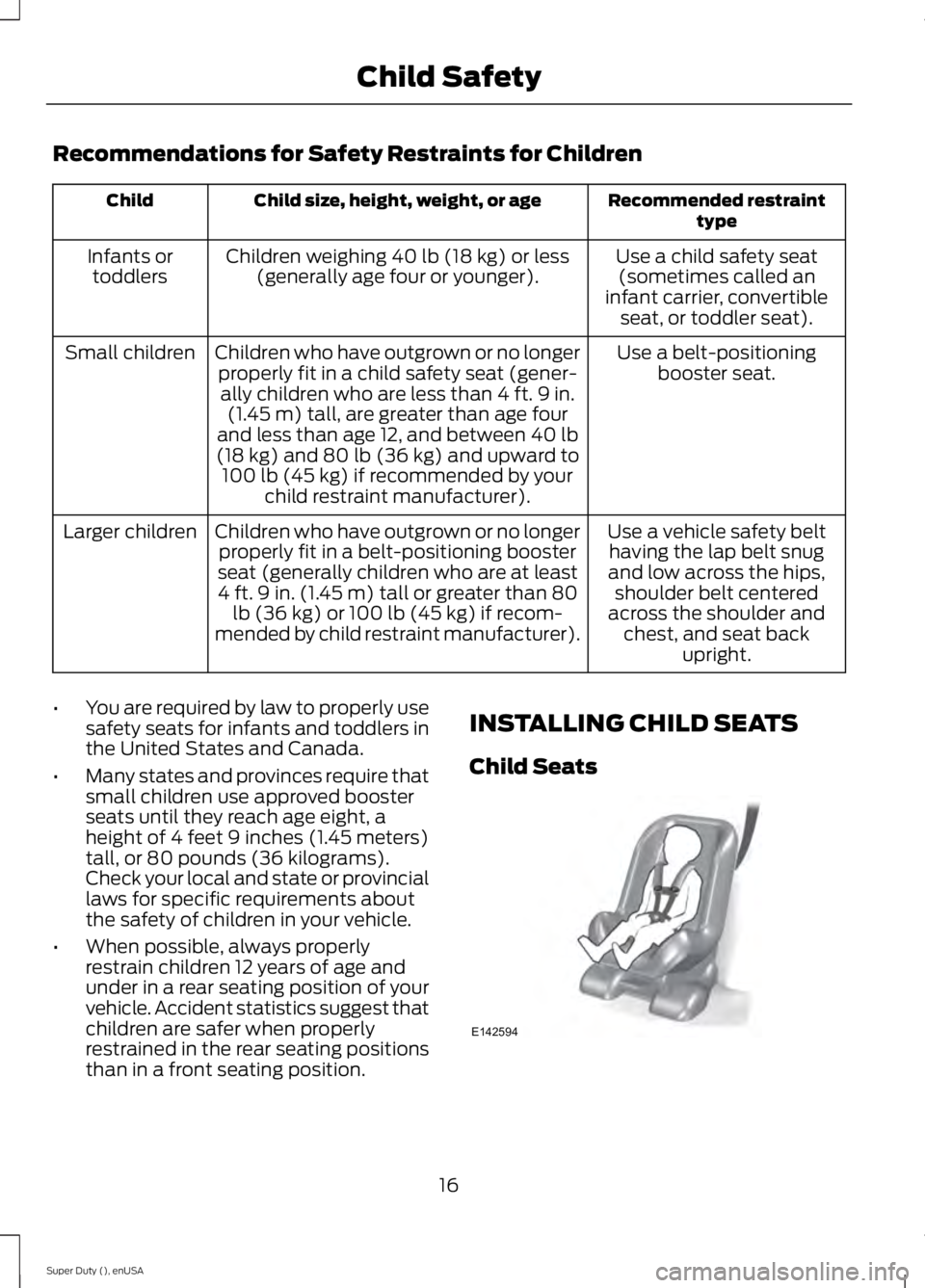
Recommendations for Safety Restraints for Children
Recommended restraint
type
Child size, height, weight, or age
Child
Use a child safety seat(sometimes called an
infant carrier, convertible seat, or toddler seat).
Children weighing 40 lb (18 kg) or less
(generally age four or younger).
Infants or
toddlers
Use a belt-positioningbooster seat.
Children who have outgrown or no longer
properly fit in a child safety seat (gener-ally children who are less than 4 ft. 9 in. (1.45 m) tall, are greater than age four
and less than age 12, and between 40 lb
(18 kg) and 80 lb (36 kg) and upward to 100 lb (45 kg) if recommended by your child restraint manufacturer).
Small children
Use a vehicle safety belthaving the lap belt snug
and low across the hips, shoulder belt centered
across the shoulder and chest, and seat back upright.
Children who have outgrown or no longer
properly fit in a belt-positioning booster
seat (generally children who are at least
4 ft. 9 in. (1.45 m) tall or greater than 80 lb (36 kg) or 100 lb (45 kg) if recom-
mended by child restraint manufacturer).
Larger children
• You are required by law to properly use
safety seats for infants and toddlers in
the United States and Canada.
• Many states and provinces require that
small children use approved booster
seats until they reach age eight, a
height of 4 feet 9 inches (1.45 meters)
tall, or 80 pounds (36 kilograms).
Check your local and state or provincial
laws for specific requirements about
the safety of children in your vehicle.
• When possible, always properly
restrain children 12 years of age and
under in a rear seating position of your
vehicle. Accident statistics suggest that
children are safer when properly
restrained in the rear seating positions
than in a front seating position. INSTALLING CHILD SEATS
Child Seats
16
Super Duty (), enUSA Child SafetyE142594
Page 22 of 485
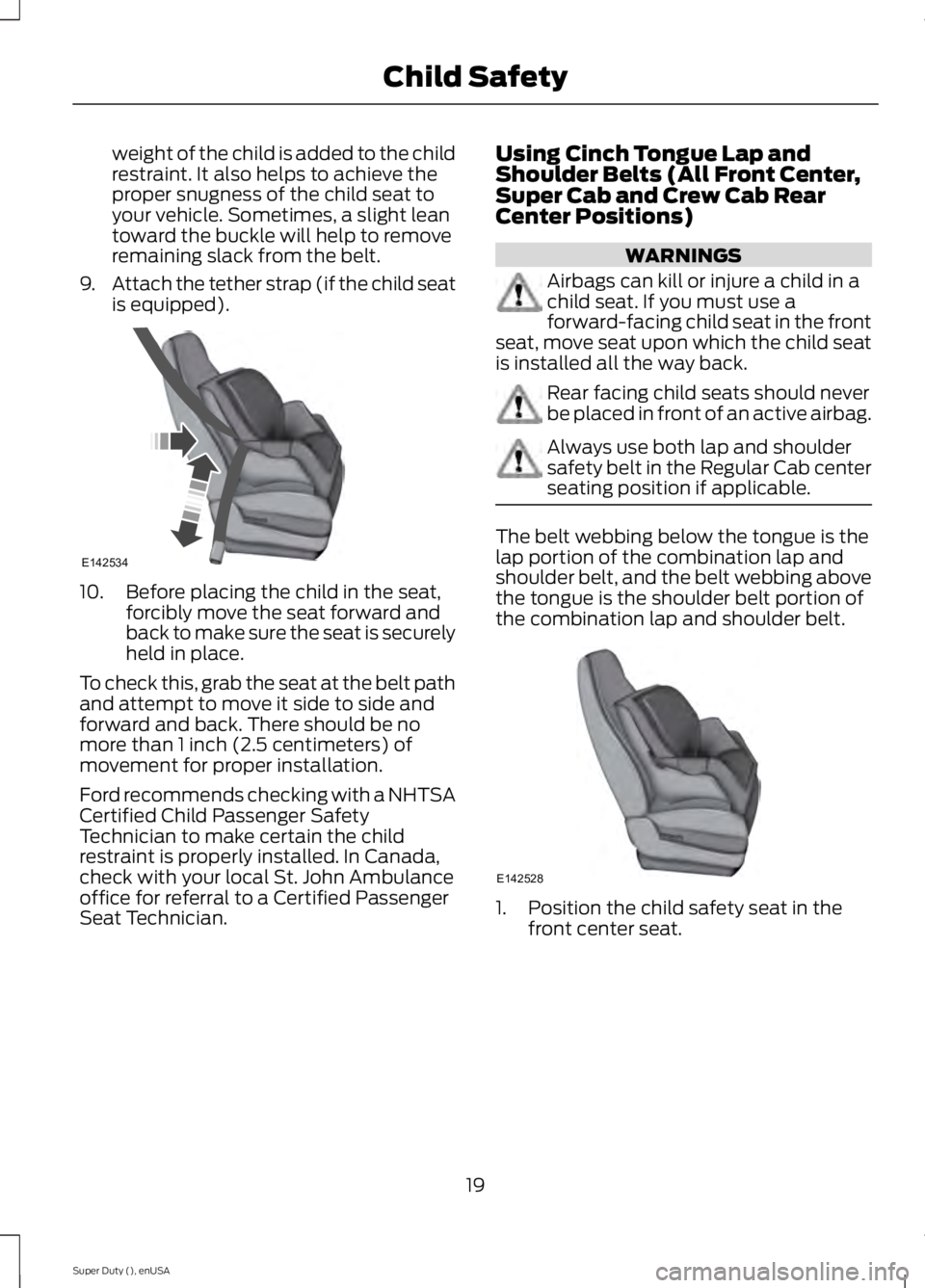
weight of the child is added to the child
restraint. It also helps to achieve the
proper snugness of the child seat to
your vehicle. Sometimes, a slight lean
toward the buckle will help to remove
remaining slack from the belt.
9. Attach the tether strap (if the child seat
is equipped). 10. Before placing the child in the seat,
forcibly move the seat forward and
back to make sure the seat is securely
held in place.
To check this, grab the seat at the belt path
and attempt to move it side to side and
forward and back. There should be no
more than 1 inch (2.5 centimeters) of
movement for proper installation.
Ford recommends checking with a NHTSA
Certified Child Passenger Safety
Technician to make certain the child
restraint is properly installed. In Canada,
check with your local St. John Ambulance
office for referral to a Certified Passenger
Seat Technician. Using Cinch Tongue Lap and
Shoulder Belts (All Front Center,
Super Cab and Crew Cab Rear
Center Positions) WARNINGS
Airbags can kill or injure a child in a
child seat. If you must use a
forward-facing child seat in the front
seat, move seat upon which the child seat
is installed all the way back. Rear facing child seats should never
be placed in front of an active airbag.
Always use both lap and shoulder
safety belt in the Regular Cab center
seating position if applicable.
The belt webbing below the tongue is the
lap portion of the combination lap and
shoulder belt, and the belt webbing above
the tongue is the shoulder belt portion of
the combination lap and shoulder belt.
1. Position the child safety seat in the
front center seat.
19
Super Duty (), enUSA Child SafetyE142534 E142528
Page 24 of 485
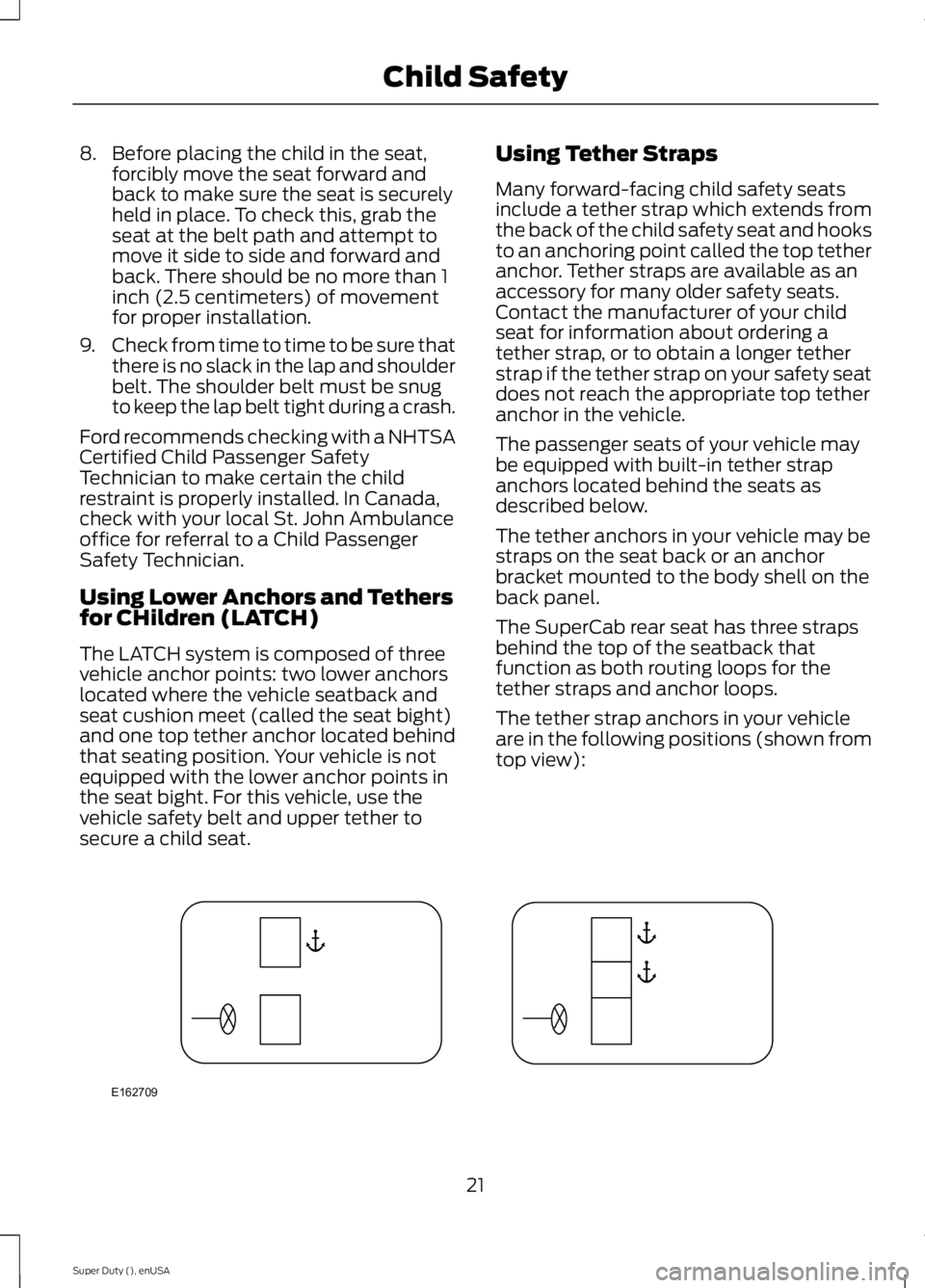
8. Before placing the child in the seat,
forcibly move the seat forward and
back to make sure the seat is securely
held in place. To check this, grab the
seat at the belt path and attempt to
move it side to side and forward and
back. There should be no more than 1
inch (2.5 centimeters) of movement
for proper installation.
9. Check from time to time to be sure that
there is no slack in the lap and shoulder
belt. The shoulder belt must be snug
to keep the lap belt tight during a crash.
Ford recommends checking with a NHTSA
Certified Child Passenger Safety
Technician to make certain the child
restraint is properly installed. In Canada,
check with your local St. John Ambulance
office for referral to a Child Passenger
Safety Technician.
Using Lower Anchors and Tethers
for CHildren (LATCH)
The LATCH system is composed of three
vehicle anchor points: two lower anchors
located where the vehicle seatback and
seat cushion meet (called the seat bight)
and one top tether anchor located behind
that seating position. Your vehicle is not
equipped with the lower anchor points in
the seat bight. For this vehicle, use the
vehicle safety belt and upper tether to
secure a child seat. Using Tether Straps
Many forward-facing child safety seats
include a tether strap which extends from
the back of the child safety seat and hooks
to an anchoring point called the top tether
anchor. Tether straps are available as an
accessory for many older safety seats.
Contact the manufacturer of your child
seat for information about ordering a
tether strap, or to obtain a longer tether
strap if the tether strap on your safety seat
does not reach the appropriate top tether
anchor in the vehicle.
The passenger seats of your vehicle may
be equipped with built-in tether strap
anchors located behind the seats as
described below.
The tether anchors in your vehicle may be
straps on the seat back or an anchor
bracket mounted to the body shell on the
back panel.
The SuperCab rear seat has three straps
behind the top of the seatback that
function as both routing loops for the
tether straps and anchor loops.
The tether strap anchors in your vehicle
are in the following positions (shown from
top view):
21
Super Duty (), enUSA Child SafetyE162709
Page 26 of 485
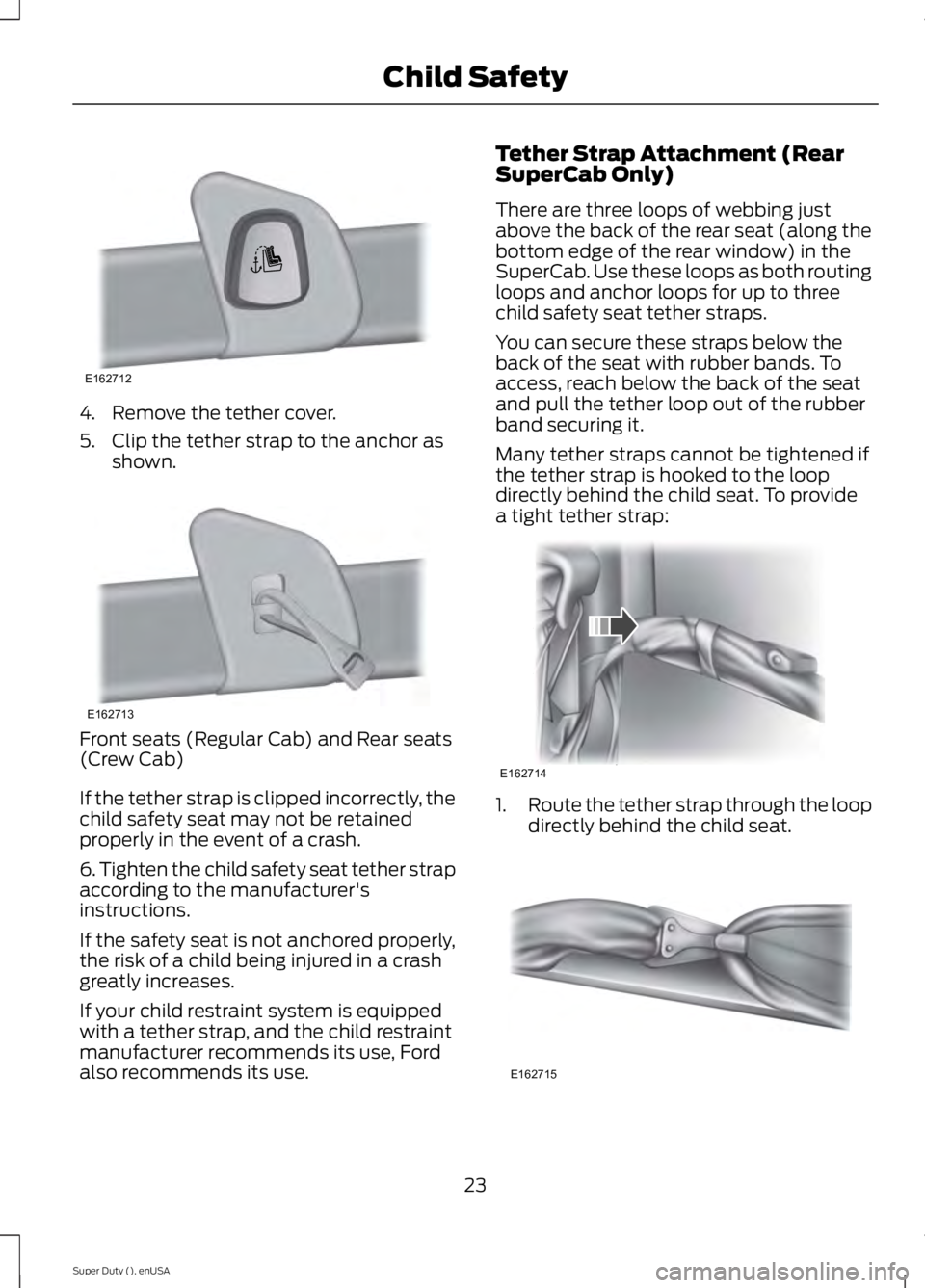
4. Remove the tether cover.
5. Clip the tether strap to the anchor as
shown. Front seats (Regular Cab) and Rear seats
(Crew Cab)
If the tether strap is clipped incorrectly, the
child safety seat may not be retained
properly in the event of a crash.
6. Tighten the child safety seat tether strap
according to the manufacturer's
instructions.
If the safety seat is not anchored properly,
the risk of a child being injured in a crash
greatly increases.
If your child restraint system is equipped
with a tether strap, and the child restraint
manufacturer recommends its use, Ford
also recommends its use. Tether Strap Attachment (Rear
SuperCab Only)
There are three loops of webbing just
above the back of the rear seat (along the
bottom edge of the rear window) in the
SuperCab. Use these loops as both routing
loops and anchor loops for up to three
child safety seat tether straps.
You can secure these straps below the
back of the seat with rubber bands. To
access, reach below the back of the seat
and pull the tether loop out of the rubber
band securing it.
Many tether straps cannot be tightened if
the tether strap is hooked to the loop
directly behind the child seat. To provide
a tight tether strap:
1.
Route the tether strap through the loop
directly behind the child seat. 23
Super Duty (), enUSA Child SafetyE162712 E162713 E162714 E162715
Page 27 of 485
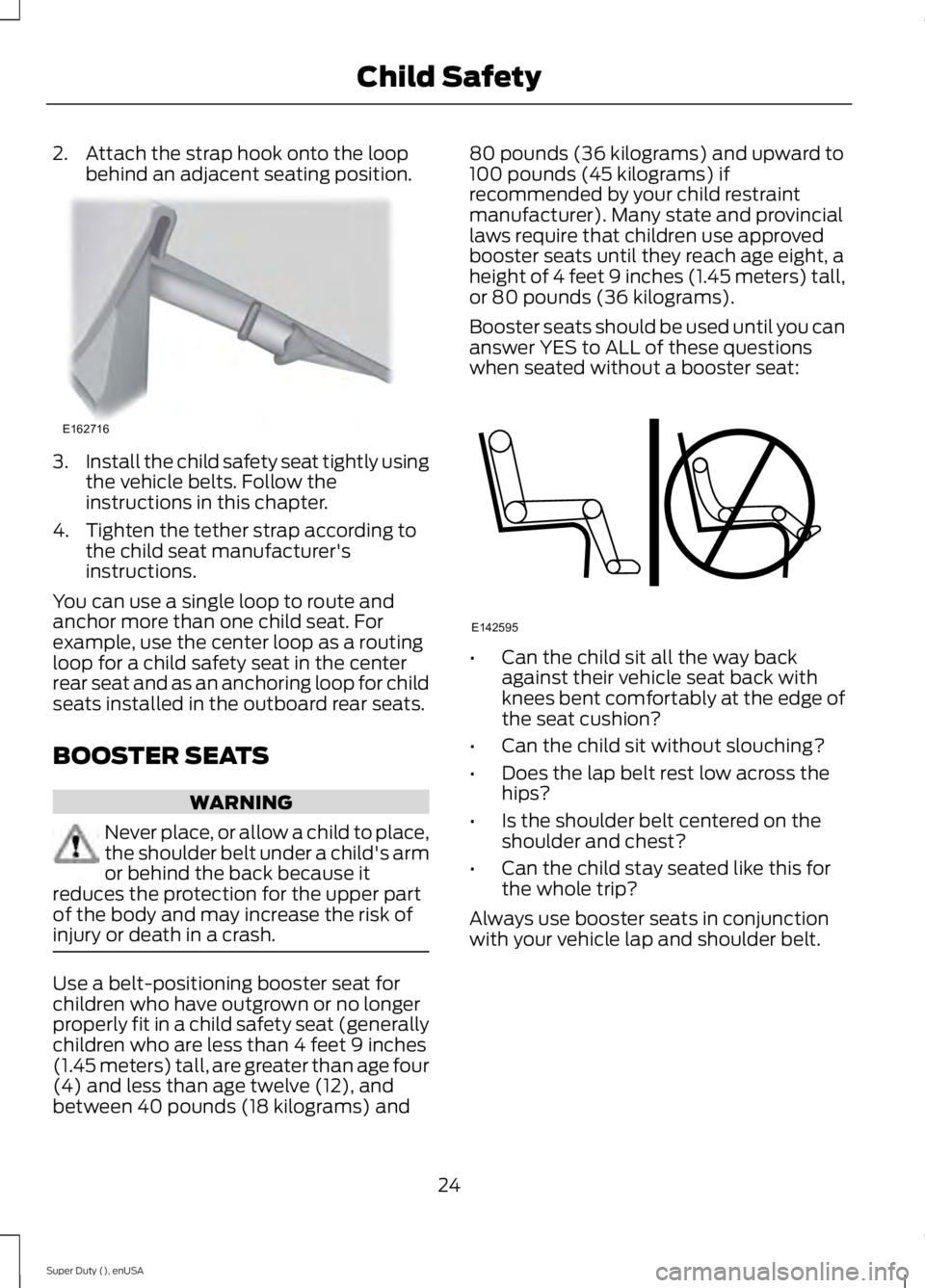
2. Attach the strap hook onto the loop
behind an adjacent seating position. 3.
Install the child safety seat tightly using
the vehicle belts. Follow the
instructions in this chapter.
4. Tighten the tether strap according to the child seat manufacturer's
instructions.
You can use a single loop to route and
anchor more than one child seat. For
example, use the center loop as a routing
loop for a child safety seat in the center
rear seat and as an anchoring loop for child
seats installed in the outboard rear seats.
BOOSTER SEATS WARNING
Never place, or allow a child to place,
the shoulder belt under a child's arm
or behind the back because it
reduces the protection for the upper part
of the body and may increase the risk of
injury or death in a crash. Use a belt-positioning booster seat for
children who have outgrown or no longer
properly fit in a child safety seat (generally
children who are less than 4 feet 9 inches
(1.45 meters) tall, are greater than age four
(4) and less than age twelve (12), and
between 40 pounds (18 kilograms) and 80 pounds (36 kilograms) and upward to
100 pounds (45 kilograms) if
recommended by your child restraint
manufacturer). Many state and provincial
laws require that children use approved
booster seats until they reach age eight, a
height of 4 feet 9 inches (1.45 meters) tall,
or 80 pounds (36 kilograms).
Booster seats should be used until you can
answer YES to ALL of these questions
when seated without a booster seat:
•
Can the child sit all the way back
against their vehicle seat back with
knees bent comfortably at the edge of
the seat cushion?
• Can the child sit without slouching?
• Does the lap belt rest low across the
hips?
• Is the shoulder belt centered on the
shoulder and chest?
• Can the child stay seated like this for
the whole trip?
Always use booster seats in conjunction
with your vehicle lap and shoulder belt.
24
Super Duty (), enUSA Child SafetyE162716 E142595